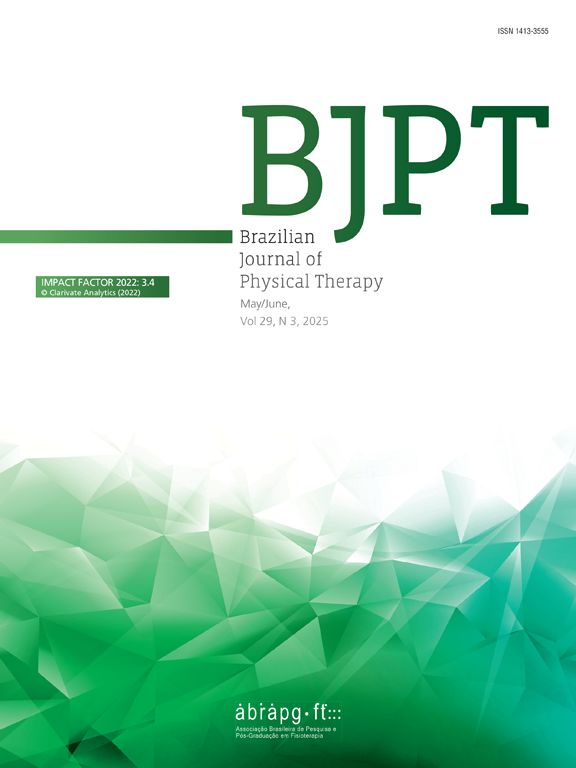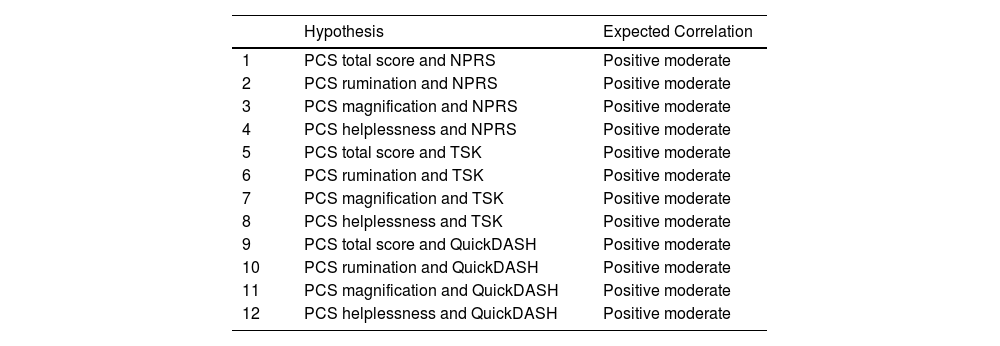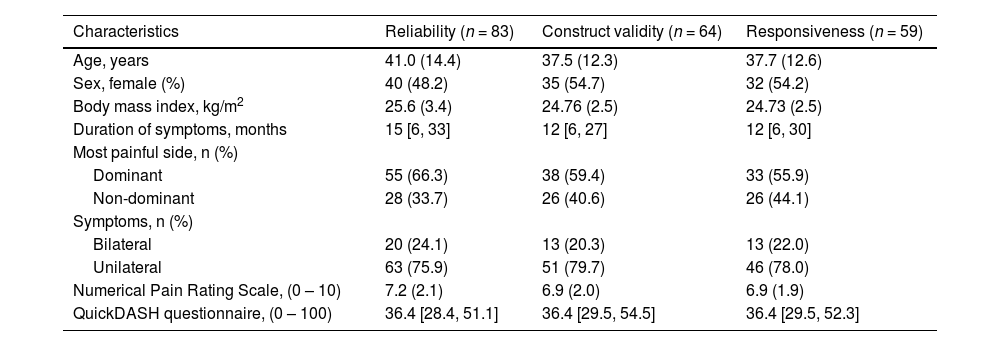Rotator cuff-related shoulder pain (RCRSP) is a common musculoskeletal disorder. Chronic symptoms, high-level pain intensity, and disability are associated with high levels of pain catastrophizing in this condition. Although the Pain Catastrophizing Scale (PCS) is widely used to assess pain catastrophizing in individuals with chronic symptoms, its measurement properties are still unknown for assessing individuals with chronic RCRSP.
ObjectivesTo assess construct validity, reliability, and responsiveness of the PCS in individuals with chronic RCRSP.
MethodsEighty-three adult individuals with chronic RCRSP were included in this study. The assessment of construct validity was based on hypothesis testing. Spearman's rank correlation coefficient was used to verify the correlation of the total score and rumination, magnification, and helplessness subscales of the PCS with pain intensity, disability, and fear of movement. Test-retest reliability was analyzed with Intraclass Correlation Coefficient (ICC)(3,1) and internal consistency was analyzed with Cronbach's alpha. Responsiveness was analyzed by effect sizes and the area under the receiver operating characteristic curve (AUC).
ResultsThe PCS showed significant moderate correlation (rho ≥ 0.40) with fear of movement (95% confidence interval [CI]: 0.23, 0.70), pain intensity (95% CI: 0.14, 0.64), and disability (95% CI: 0.17, 0.66), except the rumination and magnification subscales, which showed significant weak correlation with pain intensity (95% CI: 0.14, 0.58) and disability (95% CI: 0.12, 0.56), respectively. PCS presented good reliability (ICC > 0.7, 95% CI: 0.63, 0.88), and adequate internal consistency (Cronbach alfa > 0.7) and responsiveness based on effect sizes and AUC.
ConclusionThe PCS is a valid, reliable, and responsive instrument for assessing individuals with chronic RCRSP.
Rotator cuff-related shoulder pain (RCRSP) is a frequent musculoskeletal condition1–4 and one of the main reasons for seeking physical therapy care.5 The estimated prevalence of RCRSP ranges from 9.7% to 62% in the general population,6 with a lifetime prevalence of up to 70%.7 Additionally, the symptoms may persist for one year or more in approximately 40% of patients.8,9 RCRSP negatively impacts functional activities,10 sports performance, work productivity,11,12 and healthcare expenses over time due to secondary care and work absenteeism.13 High levels of pain intensity and disability in individuals with chronic RCRSP have been associated with some psychological factors, including pain catastrophizing.14,15
Pain catastrophizing is defined as an exaggerated mental set focusing on negative aspects of a condition or anticipated pain experience.16,17 It involves expecting worst outcome during painful experiences, magnifying the severity of the pain, and inability to cope effectively with pain.16,18 Catastrophic thoughts are frequently associated with fear of pain or potential threats and hypervigilance behavior to avoid worsening the symptoms, which may contribute to avoidance behaviors and withdrawing from social activities and physical inactivity, depression, and increased disability.19–21
Pain catastrophizing has shown to be an important psychological factor to be addressed in the management of shoulder pain.15,21–23 High levels of pain catastrophizing have been associated with increased disability and pain intensity,15,23 and worse outcome after surgical,24,25 and conservative treatments.26 Individuals with higher levels of pain catastrophizing tend to present negative scapular assistance test result27 and central sensitization symptoms in chronic RCRSP conditions.28 Pain catastrophizing has been considered a modifiable psychological factor, being moderated by optimism.29 In addition, low level of catastrophizing is a predictor of benefit from high volume resistance exercises.30 A systematic review identified positive effects of cognitive-behavioral therapy, multimodal treatment, exercise, mindfulness and meditation, and acceptance and commitment therapy on pain catastrophizing in individuals with chronic pain.31 Therefore, clinicians should use the PCS to assess individuals with RCRSP and determine those who have high levels of pain catastrophizing. This approach can guide the selection of interventions that focus on psychological factors and may enhance outcomes.
Assessment of pain catastrophizing is essentially important in clinical practice to support tailored interventions when pain catastrophizing is present.21,22 The Pain Catastrophizing Scale (PCS) is a self-reported outcome with three domains: rumination, magnification, and helplessness.32 The measurement properties of the PCS have been tested in several conditions, such as breast cancer survivor,33 acute and chronic low back pain,34,35 osteoarthritis,36 ankylosing spondylitis,37 fibromyalgia,38 and whiplash.39 Although the PCS is widely used to assess pain catastrophizing in several chronic musculoskeletal conditions, its measurement properties in individuals with chronic RCRSP are still unknown. Therefore, the purpose of this study was to investigate the construct validity, reliability, and responsiveness of the PCS in individuals with chronic RCRSP.
MethodsThis is a secondary analysis of previous studies40–42 performed at the Universidade Federal de São Carlos (UFSCar), São Carlos, SP, Brazil, which were approved by the Institutional Review Board of the UFSCar. This study followed the recommendations of Guidelines for Reporting Reliability and Agreement Studies (GRRAS)43 and the COnsensus-based Standards for the selection of health Measurement INstruments (COSMIN).44 All individuals signed a written consent before study enrollment.
Individuals were eligible to participate in this study if they were 18 years or older, reported shoulder pain during arm elevation in a self-selected plane with an intensity of at least three points measured by 11-point Numerical Pain Rating Scale (NPRS), and with duration of the symptoms for at least three months. Individuals were excluded if they presented a history of humerus, scapula, or clavicle fracture; shoulder dislocation or instability based on a positive apprehension test and/or sulcus test; massive rotator tear based on a positive drop-arm test; signs of shoulder pseudoparalysis; surgery in the shoulder region; pregnancy; frozen shoulder; numbness or tingling of the upper limb reproduced by the cervical compression test or upper limb tension test; diabetes, rheumatologic, or neurologic diseases; or received physical therapy treatment in the six months prior to the study.41
A minimum of 50 individuals is suggested for determining measurement properties of a patient-reported outcome measure.45 Eighty-three individuals were included in the reliability analysis, and of those, 64 and 59 participated in the validity analysis and responsiveness analysis, respectively. This study is a secondary analysis of previous studies from our laboratory. Unfortunately, in one study, Tampa Scale for Kinesiophobia data were not collected as it was beyond the study's scope, excluding those individuals from the construct validity assessment. In addition, not all individuals received treatment, which prevented them from being included in the responsiveness analysis.
Assessment of measurement propertiesConstruct validityValidity refers to the degree to which an instrument truly measures the constructs that is intended to measure, and construct validity is the degree to which the scores of the measurement tool is consistent with a hypothesis, based on the constructs to be measured.46 The hypothesis testing for assessment of construct validity was based on previous studies that investigated the measurement properties of PCS in other languages or diseases, including Argentine Spanish34 and Chinese47 with individuals with chronic low back pain,34 chronic pain,47,48 and knee osteoarthritis.36 The hypothesis of this study is that the rumination, magnification, and helplessness subscales and total score of the PCS are moderately (r > 0.40) and positively associated with pain intensity, upper limbs disability, and fear of movement, resulting in 12 hypothesis testing (Table 1).34,36,47,48 Terwee et al. suggest that for construct validity to be considered acceptable, at least 75% of the hypotheses being tested should be confirmed.45,49
Expected correlations between Pain Catastrophizing Scale and other instruments as a priori hypothesis.
Abbreviations: NRPS, Numerical Pain Rating Scale; PCS, Pain Catastrophizing Scale; QuickDASH, Quick version of Disabilities of the Arm, Shoulder and Hand; TSK, Tampa Scale for Kinesiophobia.
Reliability refers to the degree that the instrument is free from measurement error.50 Test-retest reliability, internal consistency, and measurement error were used to analyze reliability. For the analysis of test-retest reliability, the PCS was applied twice under similar conditions (same physical therapist and self-administered in a laboratory setting), with a mean interval of 7.55 ± 3.34 days (ranging between 4 and 12 days) between applications. The interval between applications minimized the likelihood of changes in symptoms and recall.45 The individuals were asked and confirmed that they did not receive any treatment during that period.
Internal consistency assesses the degree to which items within a questionnaire (or subscale) are interrelated with each other, indicating their homogeneity and ability to measure the same underlying concept.45,46 The measurement error was assessed with Minimal Detectable Change (MDC) and Standard Error of the Measurement (SEM).45 The SEM refers to the measurement error in the same unit as the measurement itself.45 The MDC represents the smallest change or difference that is distinguishable from measurement error and can be considered a true difference.50
InterpretabilityInterpretability refers to how easily one can attribute qualitative meaning, such as clinical or commonly understood connotations, to the quantitative scores or changes in scores of an instrument.46 The analysis of interpretability includes the presence of floor and ceiling effects.50 Floor and ceiling effects of the PCS subscales (rumination, magnification, and helplessness) and the total score were considered present if a large part of the sample (more than 15%) achieved scores at either the lower or upper end of the scale, respectively.50 Floor and ceiling effects may indicate limited content validity and reduce the responsiveness and sensitivity of the instrument to detect differences between groups.45
ResponsivenessResponsiveness refers to the ability of an instrument to detect changes over time in the construct to be measured.50 Responsiveness of PCS was assessed in individuals that received eight weeks of treatment for RCRSP based on exercises.
Outcome measuresPrimary outcomePain Catastrophizing ScaleThe Brazilian version of Pain Catastrophizing Scale (PCS) was used to asses pain catastrophizing, which is divided into three domains: rumination, magnification, and helplessness.51,52 The score of the rumination subscale is obtained summing items 8, 9, 10, and 11, and ranges from 0 to 16. The score of the magnification subscale is obtained summing items 6, 7, and 13, and ranges from 0 to 12. The score of the helplessness subscale is obtained summing items 1, 2, 3, 4, 5, and 12, and ranges from 0 to 24. The PCS total score is obtained summing all items and ranges from 0 to 52 points. Higher scores indicate higher levels of pain catastrophizing. The Brazilian version of PCS was tested in individuals with chronic nonmalignant pain and presented adequate reliability (ICC= 0.92).51
Secondary outcomesTampa Scale for Kinesiophobia (TSK)The Brazilian version of TSK was used to assess fear of movement, which is a self-reported instrument with 17 items.53 The score ranges from 17 to 68 points and higher scores indicate higher levels of fear of movement. The TSK presented adequate test-retest reliability (ICC= 0.85).54
Numerical pain rating scale (NPRS)The 11-point NPRS was used to measure the frequent pain intensity of the shoulder in the past 24 hours. The NPRS score ranges from 0 to 10, with higher scores indicating worse painful symptoms. The NPRS is reliable and valid for assessing individuals with shoulder complaints (ICC= 0.84).55
Quick disabilities of the arm, shoulder, and hand (QuickDASH)Upper limb disability was assessed with the Brazilian version of QuickDASH. The QuickDASH is a self-reported questionnaire with 11 items, with score ranging from 0 to 100, and higher scores indicate worse disability. The Brazilian version of QuickDASH questionnaire showed adequate reliability (ICC= 0.81).56
Global rating of change scale (GROC)The GROC was used to measure the individual's perception of improvement or worsening over time (from baseline to 8 weeks after treatment). This scale ranges from –7 to 7, with negative scores indicating perception of worsening, zero indicates no change, and positive and higher scores indicating a perception of improvement.57
Statistical analysisContinuous data were presented as mean (standard deviation) or median [25th, 75th percentile] according to the Shapiro–Wilk test of normality and visual inspection of the histograms. The TSK, QuickDASH, and PCS presented non-normal data distribution, and the association between the PCS, FABQ, TSK, NPRS, and QuickDASH were examined with Spearman's rank correlation coefficient.
Test-retest reliability was evaluated using ICC(3,1) with values interpreted as follows: greater than 0.90 as excellent, 0.75 to 0.90 as good, 0.50 to 0.75 as moderate, less than 0.50 as poor reliability.58,59 Cronbach's alpha was used to evaluate internal consistency, and it was considered adequate when greater than 0.70.45 The MDC was calculated using the formula MDC90= SEM x √2 × 1.64, and the SEM was calculated with the formula SEM = SD √1 – ICC.60,61 The floor and ceiling effects were analyzed with the frequency of the responses that achieved scores at either the lower or upper end of the scale, respectively.
Responsiveness was assessed with the effect size (ES), standardized response mean (SRM), and the area under the curve (AUC) of the receiver operating characteristic (ROC). ES and SRM were interpreted as follows: less than 0.50 as small, 0.50 to 0.80 as moderate, and greater than 0.80 as large responsiveness.45,60–62 A ROC curve was plotted based on the scores of GROC, which was considered an external anchor. The external anchor (GROC) classified the individuals into two categories: “importantly improved” or “slightly improved or not improved”, considering a cut-off of 4 points.40,63,64 The AUC and 95% CI were calculated using the change scores, and AUC greater than 0.70 was considered as adequate responsiveness.45,60–62 Level of significance was set at 0.05 and all statistical analyses were conducted using the Statistical Package for the Social Sciences (SPSS Inc, Chicago, IL) version 23.
ResultsThe characteristics of the individuals are presented in Table 2.
Characteristics of individuals.
Continuous data are reported as mean (standard deviation) or median [25th, 75th percentile]. Categorical variables are presented as count and percentage.
Abbreviations: QuickDASH, Quick version of Disabilities of the Arm, Shoulder, and Hand.
Higher scores of Numerical Pain Rating Scale and QuickDASH questionnaire indicate worse condition.
The results of construct validity are described in Table 3. PCS satisfied 10 of 12 (83%) of the proposed hypotheses. PCS showed significant moderate correlation (rho ≥ 0.40) with TSK, NPRS, and QuickDASH, except for the subscales rumination and magnification, which showed significant weak correlation with NPRS and QuickDASH, respectively.
Construct validity of the of the Pain Catastrophizing Scale.
| PCS | Spearman's rank correlation coefficient (95% confidence interval) | ||
|---|---|---|---|
| TSK | NPRS | QuickDASH | |
| Rumination | 0.46* (0.23, 0.64) | 0.38* (0.14, 0.58) | 0.41* (0.17, 0.60) |
| Magnification | 0.54* (0.33, 0.70) | 0.43* (0.20, 0.62) | 0.36* (0.12, 0.56) |
| Helplessness | 0.51* (0.29,0.68) | 0.42* (0.19, 0.61) | 0.48* (0.25, 0.66) |
| Total score | 0.54* (0.33, 0.70) | 0.46* (0.23, 0.64) | 0.46* (0.23, 0.64) |
Abbreviations: QuickDASH, Quick version of Disabilities of the Arm, Shoulder, and Hand; NPRS, Numerical Pain Rating Scale; PCS, Pain Catastrophizing Scale; TSK, Tampa Scale for Kinesiophobia.
The rumination, magnification, helplessness, and total scores of the PCS presented good reliability (ICC > 0.7). Internal consistency was considered adequate in all subscales and for the total score (Table 4). The PCS subscales and total score did not present floor or ceiling effect (Table 4).
Reliability and internal consistency analysis of the Pain Catastrophizing Scale (n = 83).
Abbreviations: CI, Confidence Interval; ICC, Intraclass Correlation Coefficient (Two-way mixed model, consistency, single measurement); MDC, Minimum Detectable Change; PCS, Pain Catastrophizing Scale; SEM, Standard Error of Measurement.
The results of responsiveness are described in Table 5. The rumination, helplessness, and total scores of the PCS presented large ES and SRM, and the subscale magnification presented moderate ES and SRM. All subscales and total score of the PCS presented adequate AUC (greater than 0.7).
Responsiveness of Pain Catastrophizing Scale (n = 59).
Abbreviations: AUC, area under de curve; CI, confidence interval; PCS, Pain Catastrophizing Scale; SD, Standard Deviation; SRM, Standardized Response Mean.
The findings of this study indicated that the PCS presented adequate construct validity (with more than 75% of predefined hypotheses confirmed), good reliability, and adequate internal consistency and responsiveness, indicating that this instrument is suitable to be used in clinical practice and research. The hypothesis testing for assessment of construct validity was based on previous studies that investigated the measurement properties of PCS in other languages or diseases.34,36,47,48 Those previous studies also observed moderate correlation of PCS with pain intensity, disability, and fear of movement,34,36,47,48 indicating that PCS has adequate construct validity for assessing individuals with RCRSP. Floor and ceiling effects are frequently present when an existing measurement instrument is used in different population.50 Nevertheless, the findings of this study indicated that the PCS did not present floor or ceiling effect, indicating that its content is adequate for the assessment of individuals with chronic RCRSP.
The PCS presented good reliability and adequate internal consistency in individuals with chronic RCRSP, that are in agreement with PCS in other languages or used in other conditions.34,65,66 A systematic review67 observed that all languages versions of the PCS showed sufficient internal consistency when assessing whole items, which is in agreement with the findings of this study. Additionally, this study provided SEM and MDC90 of PCS in individuals with chronic RCRSP. Clinicians and researchers can interpret changes over time considering SEM and MDC, and to make decisions as whether the changes in score of PCS represents real change.68
The findings of this study indicated that PCS presents adequate responsiveness, considering the AUC, ES, and SRM. Responsiveness of PCS was previously reported in individuals with chronic low back pain,69 chronic non-specific neck pain,70 or chronic musculoskeletal pain.71 Those studies observed large SRM71 and ES and AUC ROC of 0.84 (95% CI: 0.76, 0.92)70 and 0.84 (95% CI: 0.71, 0.98).69 In this study, the SRM and ES were also large with AUC ROC of 0.77 (0.62, 0.91). Although PCS was demonstrated a valid instrument while associated with TSK, a recent study identified that the TSK and Fear Avoidance Beliefs Questionnaire may not present adequate responsiveness in individuals with RCRSP, based on AUC.40 Therefore, the PCS may be an adequate alternative for assessment of psychological impairment in individuals with chronic RCRSP.
The findings of this investigation contribute to the growing body of literature on the measurement properties of instruments used to assess psychological impairments in individuals with chronic RCRSP. The strengths of this study are that it provided comprehensive information about the construct validity, reliability, measurement error, and responsiveness of an important and widely used assessment tool. This ensures the utility of the PCS for clinicians and researchers in accurately evaluating individuals with chronic RCRSP.
Nevertheless, this study has some limitations. We used the Brazilian version of PCS, and the findings of this study should not be generalized to other versions, or individuals with different characteristics of those included in this study, such as individuals with acute pain or with other musculoskeletal conditions. The recommended sample size for conducting confirmatory factor analysis for assessment of structural validity is at least 150 individuals.72 Therefore, confirmatory factor analysis was not conducted in this study due to the small sample size, which is used to test whether the data fit the hypothesized factor structure.50 This study is a secondary analysis of previous studies and for one of those studies, the data of an instrument used for construct validity was not collected, which may limit external validity of our study. In addition, the PCS should be used for individuals with RCRSP who have characteristics similar to those included in this study. Further investigations are still needed on confirmatory factor analysis and for determining minimally clinically important differences in individuals with chronic RCRSP, as well as investigations on measurement properties in individuals with different shoulder-related disorders.
Despite the limitations, this study has important clinical implications. Clinicians can use PCS to identify individuals with chronic RCRSP and high levels of pain catastrophizing, supporting tailored interventions. This approach could result in more comprehensive treatment plans and potentially improve treatment outcomes. The research implications of this study include using PCS in future studies that can explore the association between pain catastrophizing and other clinical factors, as well as mediation effect on outcomes. Such research can enhance the understanding of the role of psychological factors in pain perception and treatment response. Additionally, clinicians and researchers should consider 4.78 points of the total score of PCS as the SEM, representing the measurement error, and 11.10 as the MDC, indicating the smallest detectable change that can be distinguished from measurement error.
ConclusionThe PCS showed adequate construct validity, good reliability, and adequate internal consistency and responsiveness in the assessment of individuals with chronic RCRSP. This study also provided MDC and the SEM that may be considered when interpreting the results of the PCS.
The authors declare no competing interest.
This study was supported by Fundação de Amparo à Pesquisa do Estado de São Paulo – FAPESP (2018/04911-1), Coordenação de Aperfeiçoamento de Pessoal de Nível Superior - Brasil (CAPES), and Conselho Nacional de Desenvolvimento Científico e Tecnológico - CNPq (142373/2018-4). The funders played no role in the design, conduct, or reporting of this study.










